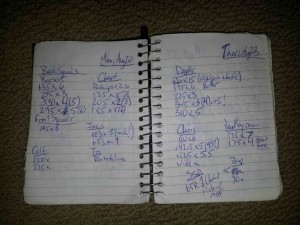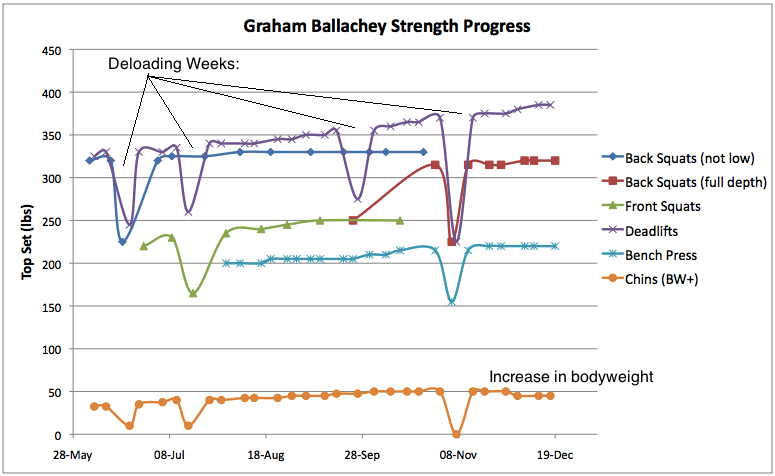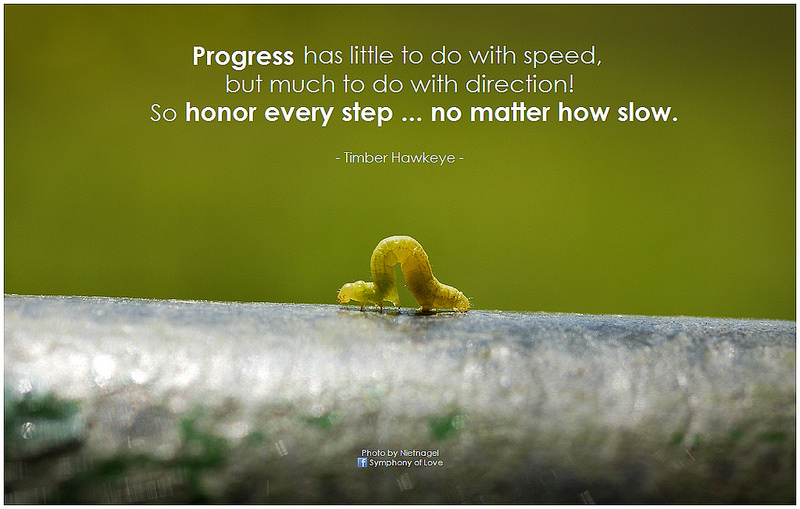Featured photo courtesy of symphony of love. Note: This was originally written at my other blog, so the dates may seem a little off. I found the article still had value, so I reposted it here. Enjoy!
Introduction:
Here’s what I see happen with great frequency: Someone will decide to get fit/in shape, and will commit to a fitness routine that is either ineffective, or way more than they really need involving hours of training a day or multiple different goals all at once.
Eventually, they burn out, start to feel tired more often, get bored/frustrated with it, and eventually ditch it all together. They fall back into their old patterns and make no change in their body only to make the same commitment the sometime down the road and repeat the cycle.
From what I see, I think this is because most people (including some trainers…), really have no concept of how simple it is to change your body to become stronger, leaner, more athletic, and all-around more resilient (and sexier, because why not?). Like I talked about in my post on the context of vices, to change the body, it must be stressed, and then allowed to recover. The recovery portion is where adaptations to the stressor are made. Provided sufficient recovery to the stressor, we come back more resilient. In the context of physical fitness, the stressor is your training, and the recovery is food, sleep, and time.
People often ask me things like “So you must go to the gym like two hours a day right?” To that I can only laugh, and reply “dude, you think I have time for that? It’s not even two hours a week”. I like training routines that are simple, time-efficient, and effective. Here’s my take on it: The keys to efficiently changing your body are three-fold:
- Decide on your goals and choose a training style to meet those goals.
- Set a schedule.
- Measure your results over time. Adapt as necessary.
Here’s the routine that I set for myself a couple of years ago, and have adapted a bit as I progressed, but really not by much. Here’s another for someone looking to start out with bodyweight training. I’ll reiterate how I decided upon such an approach, and then show my results, and set sights for moving forward.
Decide on Your Goals and Training Style:
First things first. Ask yourself these questions: Why do I want to train? What is it about myself that I want to change? What do I want to be able to do in the future that I can’t do now? These questions will lead to the question of: What will the training be? This is when you will decide how to get stronger. Just “going to the gym” is not going to cut it. Anyone can walk into a gym and play around for a while, but that is very unlikely to get you anywhere specific. The key to meeting your goals, is first to determine exactly what your goals are. This will vary by individual, but perhaps not as much as you’d think. For most, I gather that goals are generally fat loss, muscle gain, or the ineffable “fitness”. When it comes to fat loss, exercise can help, but the most important factor in having a relatively lean body is your eating habits. Muscle gain comes from building stronger muscles, period. What is fitness exactly though? There is really no hard definition, other than to be “fit” for specific physical demands, so it changes based on what that demand is. A marathon runner may be considered “fit” by some, but if that marathon runner can’t do a single chin-up, is he/she really overall “fit”? I don’t think so. Here are my (simple) goals:
- All-around athleticism
- Minimize risk of physical injury in all aspects of life
- Enough practical endurance for most sports or physical work
- A lean, proportioned, muscular physique
That’s all folks. I love playing sports when I have the time and a fun group of people to play with, but when it comes down to it, I’m an applied scientist, and not a pro-athlete. I accepted that long ago. I like hiking, biking, ultimate Frisbee, baseball, basketball, football, tennis, snowboarding, swimming, and many others, but I’m not obsessed with any one in particular (ultimate is probably my favourite). They’re all just for fun with friends. I want to know that when I do play sports, I’m going to be good enough to be competitive, and fit enough to not hurt myself, but beyond that I really don’t care about being incredible at any one sport. I feel as though this is true for almost everyone, but I concede that some people will want to be a lot more specific than me. Fair enough.
I’ve never found that focusing on cardiovascular training has lead to an increase in all-around athleticism or towards my physique goals. By this I mean really long-duration, moderate to intense cardio. I don’t bother with going for long runs, or biking hard for hours at a time as I’ve never found these helped me achieve my goals. Lower-intensity cardiovascular effort (walking, hiking, easy bike rides, swimming around, etc.) is great and a big part of overall health, but it won’t provide your body with enough stimulus to achieve new levels of peak intensity. To achieve new levels of intensity, you must push your limits. This is how to get stronger. The most effective way I found with this is through strength training.
With strength training, I can see how I perform with several factors: weight lifted, number of times lifted, and the quality (form) of my lifts. This way, I can continually challenge myself by pushing myself to go further. Tracking progress is extremely important to ensuring that every time I work out, I try to push myself a little further. I’ve tried to rely on memory, but sometimes memory is not enough. I’ve laid out my recommended strength training routine for the intermediate here, so I won’t go into detail again. The gist of it is that I choose a few compound exercises, and try to achieve five repetitions with a certain weight once a week (this is called the “top set”). If I hit my five, I up the weight slightly for the next week and try to get five again. What I really track are these top sets. If the weight I can do five times goes up over time, then I’m doing something right. If not, something’s gotta give.
Tracking Your Strength:
There’s no point in training if you’re not going to get results. Spinning your wheels but going nowhere is no way to live your life. What I do is write down my workouts in a cheap notepad (yes, I’m one of those guys in the gym). Its really simple to do, and that way I can look at what I did the last workout, and always try to improve upon it. Here’s a glimpse:

Now to analyze some results. I have compiled everything from last June onward (when I started properly tracking). Also, my cousin Alex took up this same approach last July when he moved to Vancouver. We’ll start with his results. I’m only graphing the weight of the top sets (highest weight in a training session – aiming for 5 reps) as that is the best measure of strength progress with this approach.
Alex “Form Nazi” Hobbs
Alex is a naturally bigger guy than me, with shorter arms and thicker joints and bone structure. He’d never really properly done any focused weight training, but he did hit the gym quite a bit about a decade ago, and has natural strength, so he started out pretty decent. He had been following a (mostly) primal/paleo approach to eating for a couple years, and lost quite a bit of fat in the process (he, um, had a fair amount to lose, however). He then changed his focus to getting stronger. I was impressed with his dedication to proper form from the get-go. Unfortunately, a lingering shoulder injury from volleyball lead to a decline in his performance on the bench press and chinups. However, he has made solid progress on both the squat and deadlift as seen in the figure below. His shoulder is getting closer to ready for action, and the new year hopefully will bring some improvement on his upper body lifts. He really enjoys the new strength in his core and lower body, and since the training sessions are relatively infrequent, he looks forward to each one. He plays volleyball a couple times a week on top of the training, and like me also enjoys hiking. Alex tracks his strength a little differently. He puts it on his smart phone and uploads it to www.fitocracy.com . I am way too old school for that, but he loves it.

Graham “gball” Ballachey
Now for my results. What I’ll do is show my graphed top sets over time, and then do an analysis on each lift.

Deadlifts: To me, these have been the most satisfying. I naturally have long arms as compared to my height (I’m 6’2” tall, and my reach is 6’5”), so I’m what’s called a “natural puller”. I have strong glutes, hamstrings, and lower back muscles, so proper deadlifts have come very naturally to me. I started out this year already deadlifting over 300 lbs, and am now close to 400. The New Year will see the 400 mark, and hopefully substantial progress beyond that. Deadlifts rule. My back is now strong as hell, and only getting stronger.
These have been more challenging. As you can see, I’m really not much further along than when I started tracking, at least in terms of the weight I’m training with. I still feel as though I have made good progress though. The story is as follows: I had been squatting for years, and rushed into getting into the really heavy weights due to my ego. I didn’t realize that when I went really heavy I wasn’t going to full depth (thighs at least parallel), until Alex “Form Nazi” Hobbs called me on it. It took me some time to swallow my ego and realize that I had to correct my form before I would really progress. I started focusing on front squats more for a while, and made decent progress with those as I felt it was easier to get to full depth. Then, once my hips were used to it, I started loading up back squats while going to full depth. I had to take a step back in terms of weight, and am only now getting back to where I was, but I can feel that my lower body is overall way stronger just from progressing in terms of range of motion. I’m now quite comfortable going to a low position on squats, and hopefully the New Year will see good progress with great form. Onwards and upwards. Squats are HARD! But that’s the point.
Due to my long arms and relatively small shoulder joints and bone structure, I am not what’s known as a “natural presser”. Clearly, benching 220 lbs for 4 reps (current record) is nothing to sneeze at, but compared to my lower body lifts, it’s the weakest link. I have a well-developed, muscular upper body, but the relative dimensions I’ve been given prevent me from having a really impressive bench press. It’s not ultimately about the weight being lifted so much as it is about the progress, and I have made some progress (~200 lbs to 220 lbs) over the last few months that I am happy with. I am looking to the New Year to finally be repping out 225 lbs (2 plates a side), a benchmark (pun intended) I have been working towards for a long time.
So there it is! I determined my goals, I chose my training and set a program, and tracked the results. I’m happy with my current performance, and I know that I’m making progress without putting all that much time into it.
Honestly, I am looking and feeling buffer than I ever have in my life, while barely thinking about formal training most days. Most of the time, I’m working, studying, or just trying to have fun. Getting stronger is not a huge commitment when it’s done most efficiently.
Thanks for reading! Please leave a comment and continue the discussion.
